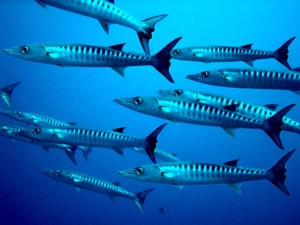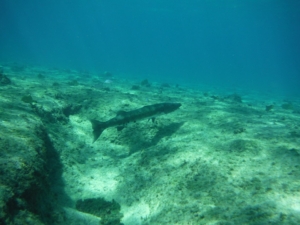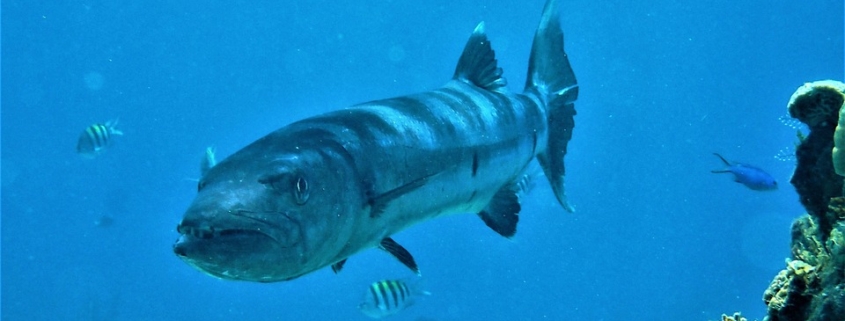With its razor-sharp teeth — resembling that of a piranha –the barracuda is one of the fiercest fish in the oceans. They are found in nearly all tropical and subtropical bodies of saltwater throughout the world. When diving in these waters, there’s a good chance you’ll encounter them. To learn more about barracudas and what to expect during an encounter, keep reading.
What Is a Barracuda?
A barracuda is a medium- to large-sized saltwater fish that’s known for its aggressive predatory behavior. They typically spend their time at or near the surface of the water where they hunt for smaller fish. Barracudas are distinguished from other fish by their large and sharp teeth. While other fish typically have short and dull teeth, barracudas have a full mouth of long, razor-sharp teeth.
Most species of barracudas have a single row of shorter — though still razor-sharp — teeth along the outside of their jaw as well as a second row of longer and equally sharp teeth behind this initial row. Using their multiple rows of razor-sharp teeth, they are able to easily attack and tear apart smaller fish.
There are over two dozen known species of barracuda, some of which include the following:
- Sharpfin Barracuda
- Arabian Barracuda
- Great Barracuda
- Pacific Barracuda
- Guinean Barracuda
- Yellowstripe Barracuda
- Bigeye Barracuda
- North Sennet Barracuda
- Heller’s Barracuda
- Pelican Barracuda
- Japanese Barracuda
- Pickhandle Barracuda
- Obtuse Barracuda
- Lucas Barracuda
- Southern Sennet Barracuda
- Blackfin Barracuda
- Sawtooth Barracuda
- European Barracuda
- Yellowmouth Barracuda
What Do Barracudas Look Like?

You can usually spot a barracuda by looking at its teeth. As previously mentioned, they all have long, razor-sharp teeth. Although there are other saltwater fish with similar teeth, barracudas are widely known for their piranha-like teeth. With that said, you won’t have the luxury of looking inside a fish’s mouth to determine whether it’s a barracuda. But there are still a few other distinguishable characteristics that can help you identify these fearsome fish.
As shown in the image to the left, barracudas have a long and slender body. They look similar to pike, which are freshwater fish featuring a long and slender body. Because of their long bodies, some divers mistake barracudas for saltwater snakes, especially when viewing them from afar.
In addition to a long and slender body, as well as piranha-like teeth, barracudas have two dorsal fins. The anterior dorsal fin consists of five spines, whereas the posterior dorsal fin consists of one spine and nine soft ways. Barracudas use these two dorsal fins to stabilize their bodies and to propel themselves more gracefully through the water.
You’ll also notice that many barracudas have an underbite. In other words, the lower section of a barracuda’s jaw typically extends farther out than the top section of its jaw. It’s a rather unique physical trait that’s not found in many other saltwater fish. If you encounter a long and slender fish with an overbite while diving, it’s probably a barracuda.
How Do Barracudas Hunt?
Barracudas are known as opportunistic predators that feast on a variety of fish. When hunting, barracudas will swill around the surface of the water while searching for other fish upon which to prey. As nocturnal marine animals, most barracudas hunt at night. It’s important to note, however, that many will still attack and eat other fish during the day if the opportunity arises.
Barracudas are attracted to shiny objects. The gold and silver scales of other fish will naturally catch the attention of a passing barracuda, especially if the barracuda is hunting for food. Upon seeing the other fish’s shiny scales, the barracuda will dart towards it, at which point it will quickly bite the fish.
Thanks to their long and slender body, barracudas are able to quickly dart through the water while hunting. Depending on the particular species, they may be able to swim at speeds of up to 27 mph. Of course, barracudas aren’t able to maintain this speed. Instead, they swim in short bursts, allowing them to easily catch fish while hunting.
Diving With Barracudas: Is It Safe?
Because of their piranha-like teeth and aggressive predatory behavior, many divers try to avoid barracudas, believing these fast-moving saltwater fish will attack them on sight. Statistics show, however, that only 25 reported attacks involving humans have occurred over the last 100 years. Therefore, you can rest assured knowing that the risk of being attacked by a barracuda is very low — even lower than that of shark attacks.
If you’re planning to dive in tropical or subtropical saltwater, you should avoid wearing jewelry. Whether it’s a metal ring, necklace, bracelet or any other metal jewelry, it may attract the attention of a barracuda. Barracudas generally hunt shiny fish, and if you’re wearing jewelry, a passing barracuda may mistake you for a fish. Barracudas typically won’t attack human divers, as well as swimmers, on sight unless they wrongfully identify the person as another fish.
You should still follow basic safety rules if you encounter a barracuda while diving, the most important of which is to avoid touching the barracuda. If you touch a barracuda, you may startle it, which could then provoke the barracuda to attack you. Again, attacks involving humans are incredibly rare, but it’s always a good idea to follow the “look but don’t touch” rule when diving.
Keep in mind, barracudas tend to live in solitude, so you probably won’t encounter any large schools of barracudas while diving. There are instances in which multiple barracudas may join together to form a school, such as when mating, but these fast-moving fish generally prefer to swim alone.
What Do Barracudas Eat?
 Barracudas eat a variety of other saltwater fish. Most of these fish are smaller than barracudas, but some can be the same size or even larger.
Barracudas eat a variety of other saltwater fish. Most of these fish are smaller than barracudas, but some can be the same size or even larger.
Some of the most common fish consumed by barracudas include the following:
- Grouper
- Snapper
- Tuna
- Anchovies
- Herring
- Mullet
Why You Shouldn’t Eat Barracudas
If you happen to catch a barracuda while fishing in the ocean, you should think twice before eating for dinner. Even when cooked, some species of barracudas aren’t safe for human consumption. Larger species like the Great Barracuda, for example, contain a toxic compound known as ciguatera. People who consume these large barracudas may then suffer from ciguatera poisoning.
As explained in this article, ciguatera poisoning is caused by the consumption of the toxin ciguatera, which is found in certain types of fish, including large species of barracudas. It often manifests as severe nausea, abdominal pain, sweating and various neurological symptoms.
Ciguatera poisoning occurs most commonly from the consumption of large barracudas. Large barracudas eat other fish that consume algae. And because ciguatera is produced by algae, these barracudas generally have higher levels of the toxin than other fish. Regardless of size, though, it’s best to err on the side of caution by keeping your barracudas off your dinner plate.
In Conclusion
Although they look fearsome, barracudas pose little or no risk when diving. Like other fish in the oceans, they are only interested in their normal food, which consists of other fish. So, if you happen to encounter a barracuda, stay calm while using this opportunity to marvel at this majestic marine animal.
Want to create your own custom dive logs? Contact us today to learn more about our custom dive logs.



